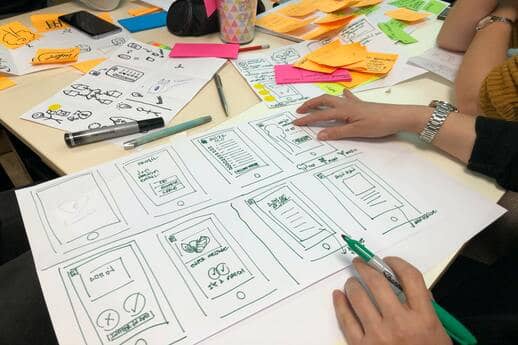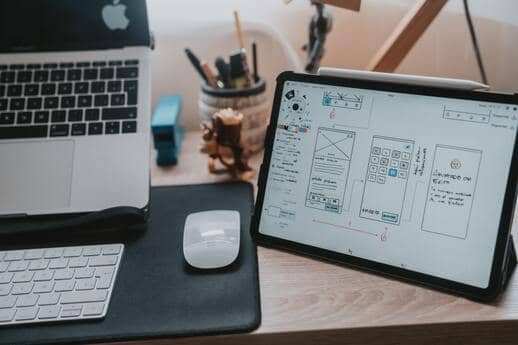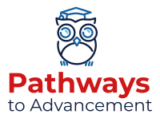For a career path that sounds very new and technical, the skills you need to become a UI/UX designer are the same skills we’ve needed since we first started making things. Yes, you’re working with code and software rather than rocks and twine. However, if you’re interested in creating products and tools that are easy to use and appealing to look at, you’ve already got the mindset necessary for a career in UI/UX design.
This guide will take you through the differences between the two major pillars of UI/UX design: user experience and user interface. We’ll cover the best education pathways for a career in UI or UX design and give you an overview of your salary and prospects in these tech careers.
Table of Contents
- UX Design vs. UI Design: Differences & Similarities
- Why Become a UI/UX Designer?
- How to Become a UI/UX Designer?
- Skills You’ll Need for a Career in UI/UX Design
- UI/UX Design Career Growth
- Building a UX Design Portfolio
- Networking and Professional Development
- Job Search and Interview Tips for UX Designers
- What Companies Hire UI/UX Designers?
- Interview Questions – Examples
UX Design vs. UI Design: Differences & Similarities
User experience and user interface design are inherently connected disciplines. A digital product needs someone to work on both aspects. However, there are distinct differences between the two professions:
UX Design
User experience is about living the journey of the user as they experience the product. When working on UX design, you’ll ask yourself questions like:
- What confused me about using the product?
- Which features jumped out to me as the most helpful? Could other parts of the product benefit from these features?
- What part of the user experience felt like it was taking too long?
- Were there any parts of the user experience that felt unnecessary?
- Did the entire journey feel complete and like I was interacting with one product or several distinct concepts?
Professionals in these tech careers have to identify and troubleshoot areas that customers will also identify. They’ll need to engage heavily with the research side of things. It’s about ensuring a smooth journey for the user and helping them feel completely engaged with the digital product.
UI Design
- Where should buttons appear, and how large should they be?
- What font should I use?
- Does the product create a harmonious experience?
In many ways, you provide the answers raised by the questions that the user experience team formulates. Optimizing the user interface is about promoting accessibility above all.
As noted above, the skills you need to understand user experience and user interface optimization aren’t “new” skills in the way that coding is a “new” skill. Think of three cavemen designing an ax:
- The development team assembles the product (head, handle, binding material).
- The UI designer decides how best to tie the head to the handle and polishes it up.
- The UX designer swings the ax around to check if it feels easy to use and does its job properly. The UX designer will report any issues to the UI designer (and possibly the development team).

Should you Learn Both UX and UI Design?
There are advantages to learning both UX and UI design. Knowing the skills required for each will help you understand how you can optimize your work to improve the other. There’s also plenty of overlap in the knowledge base: you’ll both need expert knowledge of languages like JavaScript, HTML, and CSS, for example.
However, a software team will typically assign these roles separately. There’s too much work required in both of these tech careers for one individual to perform all tasks efficiently.
Why Become a UI/UX Designer?
UI/UX design careers are incredibly varied simply because every tech product needs them. Every website you visit, every online game you play online, and every app you download all require UI/UX design work before they’re ready for the market.
And they need continuing development long after release — you know when Facebook changes its layout, and you hate it for two weeks but then realize how much better it is than the old system? That’s the work of UI/UX design professionals. The opportunities available for this career path are as varied as the web itself.
Are UX/UI Designers in Demand?
As long as websites want to attract and retain visitors, there will be a high demand for these jobs. It’s been reported that 75% of a website’s credibility comes from its interface: both user experience and user interface need to be tip-top, or customers will look elsewhere. Every business with an online presence has to pay for these services or risk falling behind the competition.
This need is growing further as smartphones replace laptops as our main tool for Internet access. A survey found that 85% of adults believed that a business’s mobile layout should be as good or better than its layout on a computer. If you’ve used your smartphone to browse the Internet recently, you’ll note with some frustration that many sites don’t deliver a good mobile experience. Every one of these pages needs to step up its UI/UX game to survive, which means continued demand for these roles.
UI/UX Designer Salary & Job Growth
The BLS provides statistics for “Web Developers and Digital Designers,” including careers other than those in UI/UX design. However, it reports the median annual salary for these professions is around $77,000 per year. It also projects growth to be 8% (much faster than average) from 2019 through 2029.
Payscale.com suggests that the average base salary of a UX designer is almost $75,000 per year, while the median base salary of a UI designer is around $65,000 per year. However, it reports that UI designers tend to benefit more from profit-sharing programs than their UX counterparts.
With salaries rising into six-figure ranges for more senior roles and strong growth on the horizon, there’s never been a better time to search for tech careers in this area.

How to Become a UI/UX Designer?
Many professionals in this field are partly self-taught, and you can find jobs in these tech careers without a degree. However, a bachelor’s or master’s degree can be advantageous when applying for roles with top employers, as competition is fierce. Below, we outline the best education pathways for these careers:
Bachelor’s Degree
A bachelor’s degree in web design or computer science can give you an edge over the competition. It shows that you have studied the technical side of the role extensively and are likely to be more than fluent in key languages such as JavaScript. A bachelor’s degree can also give you a better understanding of whether you prefer the user interface or user experience side of the job.
Master’s Degree
Master’s degrees are available for both user experience and user interface specializations. These degrees can help give you a competitive edge when applying for roles at top companies.
Master’s degrees can also be an avenue to senior positions if you’re already working in these tech careers — you can always return to studying when you have the resources to support yourself.
Certificate Programs in UI/UX Design
A certificate program is one of the best education pathways if you don’t have the time or resources for a college degree. These courses can be as short as three months and introduce you to key skills you’ll need in these tech careers, such as coding. They’re an affordable education pathway if you’re just beginning to consider moving to this field. Google offers a career certificate in UI/UX Design
UI/UX Design Boot Camps
UI/UX design boot camps are more intensive than certificate programs and often last six months to a year. These education pathways don’t just provide in-depth knowledge of the technical side of things, but they also help you find a job in a related career. They involve networking opportunities and recommend their students to employers, making it a great choice for anyone looking to transition into tech careers in this field.
UI/UX Design Courses
Many online platforms also offer free self-study resources to help you learn about user experience and user interface design. These self-study tools can be a great way to gain exposure in the field. However, they’re also valuable resources for continuous development if you already have some understanding of the industry.

Skills You’ll Need for a Career as a UI/UX Designer
Some key skills you’ll pick up in all good education pathways include:
- Coding expertise: The three main programming languages UX/UI designers use are JavaScript, HTML, and CSS. While the latter two aren’t “markup” languages rather than “programming” languages, you’ll still need to familiarize yourself with them. A solid foundation in Python never hurts, either, as it can help you build a rapport with the development team.
- Research skills: UX design is about putting yourself in the shoes of your customer. It’s also about finding out what your customers think. You’ll need to create and analyze customer surveys and understand how user data can help you optimize your product.
- Graphic design: Building a user interface means having a keen eye for aesthetics. To create a great interface, you’ll need some skills in graphics to coordinate the user interface in an appealing, accessible way.
- Problem-solving: Coming up with creative solutions to problems is the bread and butter of these tech careers. Whether that’s figuring out how to fit three essential buttons into a tight space without making the interface cramped or making useful links more accessible, problem-solving is the name of the game.
UI/UX Designer Career Growth
Below, we list the general responsibilities of people working in these careers at three levels.
Entry-Level
At first, your supervisor will task you with identifying problems in code and testing the user experience. You’ll also help with research, creating surveys, and analyzing feedback. You may assist with optimizing certain areas of the user interface.
Mid-Level
After a few years, you’ll have strong coding knowledge and will work closely with the development team to identify issues and find solutions. You’ll be in charge of optimizing the user interface if you work in UI, with significant creative control. In UX design, your main responsibility will be to ensure the product creates a smooth, positive experience for the organization you work for.
Senior Level
At the senior level, you’ll help mastermind projects. You’ll provide your team with an overview of the goals for user interface design. And, you’ll be responsible for ensuring that UX design is of the highest quality and that research is conducted thoroughly.

Building a UX Designer Portfolio
A strong portfolio is crucial for UX Designers, as it showcases their skills and expertise to potential employers or clients while demonstrating their ability to solve real-world problems through design. To create a successful UX Design portfolio, it is important to include a variety of projects that showcase different skills and techniques. Providing clear descriptions of the design process and decision-making, as well as testimonials or case studies demonstrating the impact of your work, can further enhance the credibility of your portfolio.
When creating a compelling portfolio, focus on quality over quantity, ensuring that each project represents your best work. As you gain experience and develop new skills, continuously update and refine your portfolio to reflect your professional growth and remain competitive in the field of UX Design.
Networking and Professional Development
Networking is essential for UX Designers, as it allows them to build connections within the industry that can lead to job opportunities and collaborations. Additionally, networking provides the opportunity to learn from peers and stay updated on best practices, ensuring that professionals remain at the forefront of their field. Strategies for effective networking include attending UX Design conferences and events, joining UX Design communities and online forums, and engaging with industry professionals on social media platforms.
Ongoing professional development is equally important for UX Designers. Pursuing certifications and advanced training can help professionals expand their skillset and stay competitive in the job market. Staying updated on emerging technologies and design trends is also crucial, as it enables UX Designers to adapt their work to the constantly evolving landscape of user-centered design and maintain a strong position within the industry.
Job Search and Interview Tips for UX Designers
When preparing for a job search, it is essential for UX Designers to tailor their resume and portfolio to the specific requirements of each job opportunity. Researching potential employers and understanding their needs can help candidates present themselves as the ideal fit for the position. During the interview process, candidates should focus on demonstrating their problem-solving skills through design challenges, showcasing strong communication and collaboration abilities, and asking insightful questions about the company and its design processes.
After receiving a job offer, it is important for UX Designers to negotiate the terms of their employment, taking into consideration industry salary trends and their own skills and experience. By being well-prepared and informed, UX Designers can effectively navigate the job search and interview process, ultimately securing a position that aligns with their career goals and aspirations.
What Companies Hire UI/UX Designers?
The world’s largest companies would never have succeeded without good UX/UI design. Here are a few of the biggest companies hiring UI/UX designers.
SAP: SAP helps companies across the world optimize customer engagement and product management. As a UI/UX designer working for SAP, you’ll take on various projects and find creative solutions that fulfill customers’ high expectations of SAP’s services.
Apple: Perhaps no other company in the world understands the importance of UX/UI design as Apple does. The company that made tech beautiful is always looking for sharp minds to design the next generation of smartphones and laptops. As a UI/UX designer at Apple, you could work on the company’s cutting-edge software or, at a senior level, help design industry-leading products such as the new generation of the iPhone.
J. P. Morgan: A top bank needs an exceptional user interface. With the caliber of customers it deals with, poor accessibility could cost millions or even billions in lost investment opportunities. As a UI/UX designer at J. P. Morgan, you’ll be responsible for ensuring that the company’s message and services are conveyed seamlessly to its business customers.
Interview Questions – Examples
- What are your three strengths in UI/UX web design?
- What’s the most challenging part of the job for you?
- What are the 3 most important aspects of a well-designed website?
- What are some methods you use when designing an interface for an app or website?
- How do you conduct usability testing on your designs?
- What are some of the top problems that clients usually face in UI design?
- If you could choose one, which company website has the best user experience and why?
- What are some of the current trends in web design/UX?
- What kind of design tools have you used and which one is your favorite?
- What’s your favorite type of project to work on?
- What do you like about working in this industry?
If you need more help preparing for your interview, check out our UI/UX Designer interview questions guide.
Conclusion — Becoming a UI/UX Designer
You may already know whether you’re more suited to user interface design or UX design. You may wish to give both a try — in which case we strongly recommend looking up the many free online courses that can give you a grounding in these fields. In either case, we know that there’s a fulfilling career in UI/UX design waiting for you.



